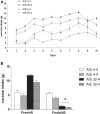Emotional Reactivity to Incentive Downshift in Adult Rats Exposed to Binge-Like Ethanol Exposure During Adolescence
- PMID: 30837923
- PMCID: PMC6389680
- DOI: 10.3389/fpsyg.2019.00315
Emotional Reactivity to Incentive Downshift in Adult Rats Exposed to Binge-Like Ethanol Exposure During Adolescence
Abstract
Alcohol use in adolescents is often characterized by binge-like ethanol consumption pattern, which is associated with long-term health consequences and even with important harms to his developing brain. Among this, ethanol exposure induces long-lasting alterations in anxiety-related neurobiological systems such as corticotropin releasing factor (CRF) or melanocortin system (MC). Recently, it has been demonstrated that adult rats exposed to adolescent intermittent ethanol (AIE) exposure exhibited anxiogenic-like behavior. Given that it has been demonstrated that negative affective state is relevant to development of addictive behavior, it is tempting to suggest that increased risk of adult abusive alcohol use exhibited in rats exposed to ethanol during adolescence may be related with differences in anxiety-related behavior. We conducted a study investigating the emotional reactivity after a reward devaluation (12-to-1 pellet or 32-to-4% sucrose downshift) in adult rats exposed to binge-like ethanol exposure during adolescence. For this aim, adolescent Sprague-Dawley rats were treated with ethanol (2.5 g/kg ip; AIE) or saline (AIS) for 2 consecutive days at 48-h intervals over a 14-day period (PND30-PND43). Following 25 free-ethanol days, adult rats were trained in consummatory and instrumental successive negative contrast task (cSNC and iSNC). Our data shows that both AIE and AIS groups exhibited suppression of the consummatory and instrumental behavior after reward devaluation relative to unshifthed control. Also, adult rats exposed to alcohol during adolescence exhibited a particularly strong negative affective state (lower sucrose consumption) with regards to the AIS group in the cSNC. This data demonstrated that adolescent binge-like ethanol exposure might trigger a greater emotional reactivity following incentive downshift, which might be linked to higher vulnerability to substance use disorder.
Keywords: adolescence; binge-like ethanol exposure; emotional state; intermittent-access ethanol paradigm; successive negative contrast.
Figures


References
-
- Amsel A. (1958). The role of frustrative nonreward in noncontinuous reward situation. Psychol. Bull. 55 102–119. - PubMed
-
- Amsel A. (1992). Frustration Theory. Cambridge: Cambridge University Press.
-
- Barr A. M., Phillips A. G. (2002). Increased successive negative contrast in rats withdrawn from an escalating-dose schedule of d-amphetamine. Pharmacol. Biochem. Behav. 77 293–299. - PubMed
-
- Becker H. C., Jarvis M., Wagner G., Flaherty C. F. (1984). Medial and lateral amígdala lesions differentially influence contrast with sucrose solutions. Physiol. Behav. 33 707–712. - PubMed
-
- Bentosela M., Mustaca A. E. (2005). Efectos del contraste sucesivo negativo consumatorio en ratas hipertensas: una cuestión de memoria. Suma Psicológica 12 87–100.
LinkOut - more resources
Full Text Sources

